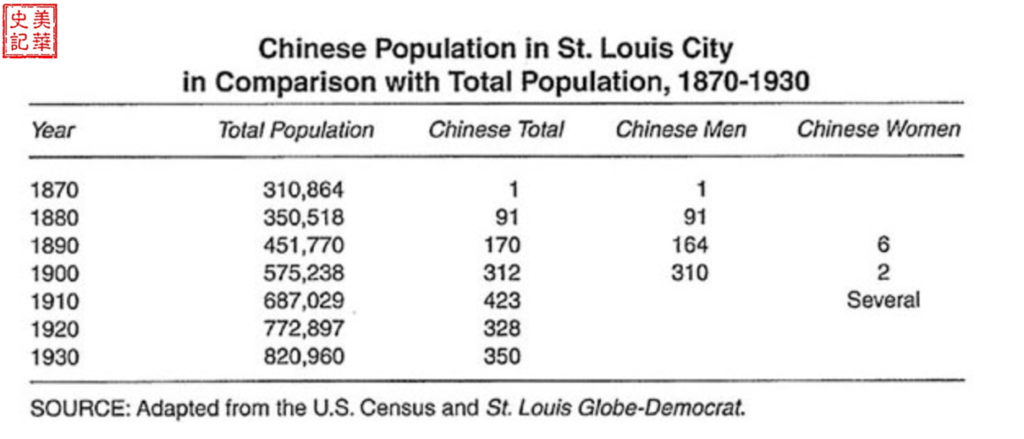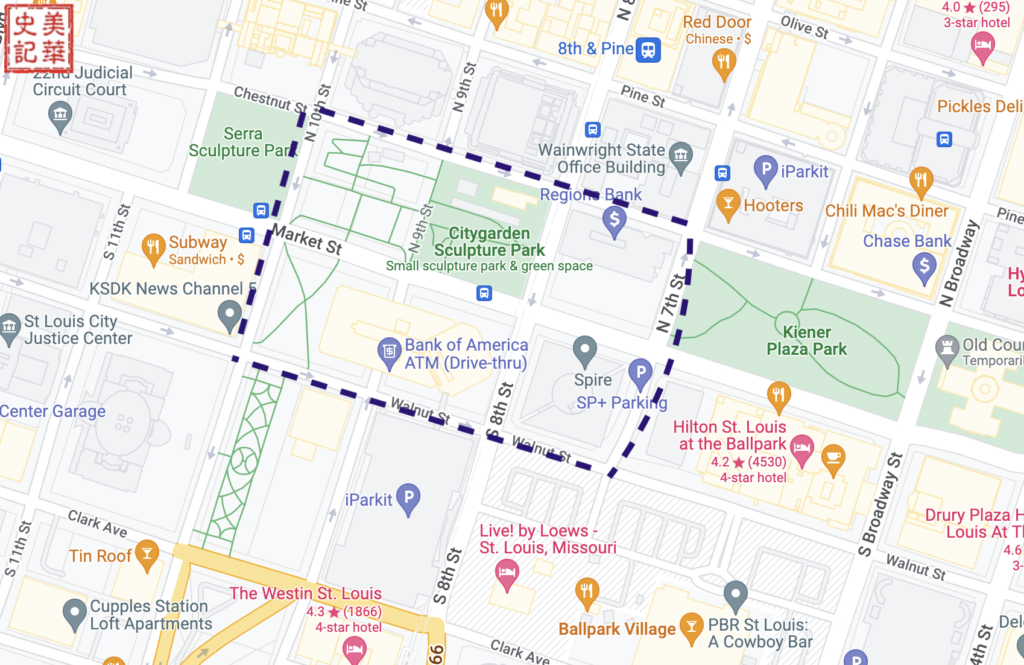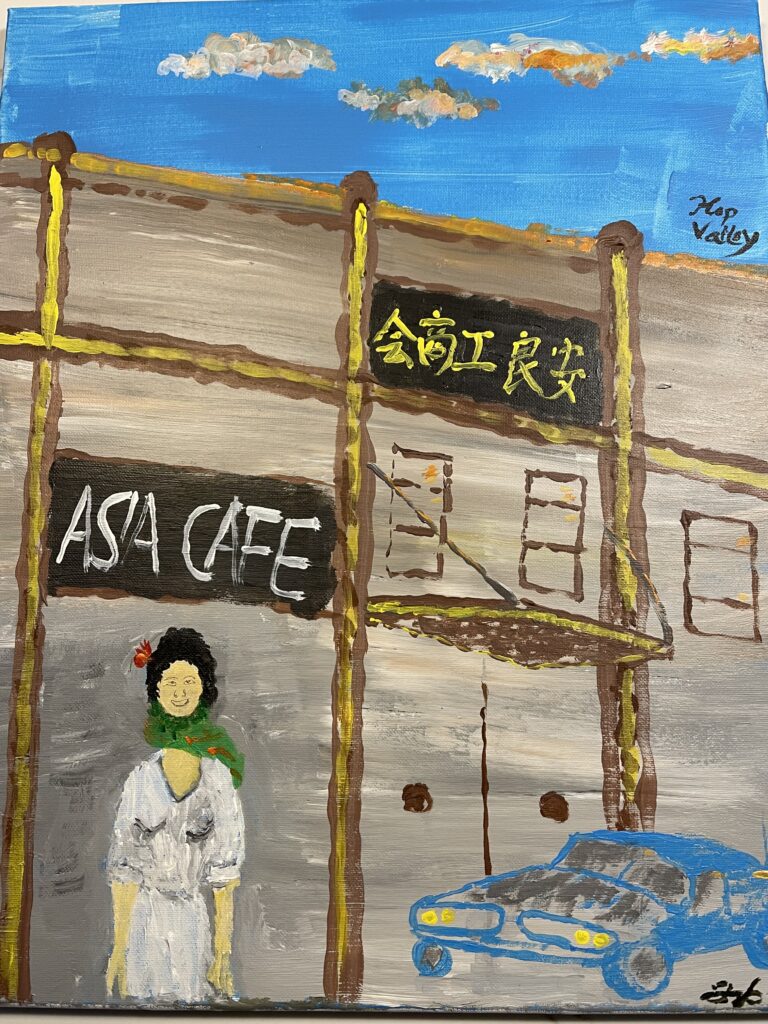Fan Jiao
The Greater St. Louis is a bi-state metropolitan area, ranked the 21st most populous area in the U.S. of 2,820,253 people with 0.6% of Chinese Americans, according to U.S. 2020 Census.1

Early Chinese Immigrants in St. Louis
The first Chinese (3 sailors) landed in the port of Baltimore, MD, two hundred and thirty-seven years ago in 1785. 2
In the mid-19th century, Chinese workers helped the U.S.’s tight labor market to pan for gold, build Transcontinental Railways, and develop the western region, making great contributions to the construction and economic development of the United States.
Since 1850, more and more Chinese have settled in San Francisco, accounted for about 10% of the city’s population (about 3,000 people)3. The Chinese worked diligently and completed well in some trades: their hand laundries didn’t use drying machines rather relying on winds to dry naturally such that they reduced the cost. The fishermen from Guangdong also were very good at fishing. That created some employment competition with the local Caucasians, plus the negative impact of opium dens4 so that the prejudice and discrimination had been on the rise then。
In 1854, California Supreme Court ruled in People v. Hall 4 Cal 399, that a Chinese could not testify against a Caucasian man in court. Then in 1882, the infamous Chinese Exclusion Act was passed. Some Chinese started leaving the city to move to other states.
The first Chinese immigrant to St. Louis was Alla Lee, who born in Ningbo,Zhejiang, and arrived in the city in 1857. While the population of Chinese Americans in the city numbered only in the hundreds for most of the 19th century, they faced intense challenges.

Hop Alley / Chinatown
The earliest Chinese settlers in St. Louis congregated in an area between Seventh, Eighth, Market and Walnut Streets, which became the Chinatown of St. Louis, more commonly known as Hop Alley where Chinese hand laundries, merchandise stores, grocery stores, herb shops and restaurants were located.5
While Chinese laundries were served to almost all the people in the city, the grocery, herb stores were mainly consumed by Chinese. Over the time the Chinese restaurants were getting popular such that actors and actresses of the entertainment industry, professionals and politicians would have lunch.

The Chinese laundromats in St. Louis Chinatown were similar to those found in other parts of the city. A typical one consists of four sections. There are offices and workshop areas in front of the laundry. This area was where the laundry staff greet customers. The private living area of the laundry worker and his family was usually in the back room behind the workshop. The third area is for drying clothes, usually done by an old-fashioned coal stove, unlike San Francisco’s Chinese laundromats, where clothes were usually hung to dry on racks on the top floor. Finally, in the back of the laundry room, there were laundry equipment such as washing machines, sinks and steam boilers.6
Oriental Tea & Mercantile Co. located at 22 South 8th Street, was the one of the oldest businesses in St. Louis Chinatown. Besides tea, and tea pots, it also sold some Chinese calligraphy and painting tools (文房四宝) and sundries.7
Orient Restaurant and Asia Café were two of the best Chinese restaurants in St. Louis then. It offered an exotic dining experience complete with hanging red lanterns and steaming Darjeeling teapots, as well as customers’ favorites, fried noodles with chicken, pork, beef, and prawns. The chow mein was not prepared ahead of time like most other restaurants, the chopped vegetables were kept cool and fresh, and then fried with the meat after ordering.8

On Leong Chinese Merchants Association
The On-Leong Chinese Merchants Association originated in New York City in November 1893. Now it has 23 chapters in the United States with 30,000 registered companies.
“On Leong”, which means “peace”, as a fraternal society that initially provided a safe haven for Chinese immigrants who were feared to be persecuted in the United States between 1882 and 1943, On Leong gradually became a fraternal society that helped immigrants with language barriers and American customs difficulties, handling immigration matters, assisting business or Personal affairs and alliances for resolving disputes and starting new businesses; it often makes provisions to prevent competition and conflict between neighboring merchants and strives to adjudicate disputes fairly. On the other hand, the association does its best to help businessmen and laborers deal with city officials in and around Chinatown. Funding comes from regular membership fees paid by members.
The St. Louis chapter was established at the turn of the century and adheres to certain Chinese traditions. For example, the idol of Guan Gong(关公), the Chinese god of merchants, guards the entrance to the headquarters, and women are not allowed to enter this fraternity, etc.
The chairman, vice chairman and secretary of the local chapter of the association are all elected by the members. Elections are held every year or two. Chinese often hold birthday parties and wedding ceremonies in the site of the association that often occupies large spaces for activities. The Hop Alley’s On Leong Chinese Merchants Association in St. Louis was on the second floor of 720 Market, was active until Hop Alley/Chinatown was forced moved away in 1966.9
Asia Cafe
Asian Cafe was a favorite meeting place for the local Chinese community. Customers met in their native language to chat, read Chinese daily newspapers, and sometimes play some mahjong. Many non-Chinese lawyers, entertainers and politicians also often were having lunch or dinner with local Chinese.10
Once in 1948, Anthony Quinn, the protagonist in “A Streetcar Named Desire”, came and gave the restaurant an autographed photo. Later “That Hagen Girl” supporting actor Rory Calhoun became a frequent guest.
Annie Leong (梁美珍) became the manager of the restaurant with her stepfather.
The restaurant was Missouri’s largest producer of fresh sprouts, offal, assorted stir-fries, and fried noodles. They were the only tofu maker in the state at the time.
In 1953, the Busch Brewing Company purchased the city’s most popular sports team, the St. Louis Cardinals baseball team. In 1959, the Chicago Cardinals of the National Football League was acquired to become the St. Louis Cardinals football team (now the Los Angeles Rams). Busch and the city of St. Louis had been negotiating for a long time to build a modern stadium that can accommodate two teams or move the team to another city. Later the city government proposed a new downtown stadium to meet the needs of retaining two sports teams in the city and provide ample parking spaces, restaurants, and hotels. As a result, the restaurant fell victim to a land clearing and requisition to build a such large stadium.11
On August 1, 1965, once the home to many patrons of Chinese laundries, grocery stores, restaurants, and many others who worked there, as the restaurant of Hope Alley, the last business in Chinatown, the Asia Cafe at 720 Market Street closed its doors permanently.
Annie Leong, Mayor of Chinatown12
Annie was born in 1934. Her father, Gee Leong, who was born in China in 1870, came to the United States in 1890, opened the New Republic Chinese Restaurant in St. Louis in 1918, and became president of the St. Louis‘ On-Leong Chinese Merchant Association and mayor of Chinatown. He returned to China in 1924 to look for a bride, and was introduced to Chin Shee, who was born in 1905; they married in April 1924.
Annie’s eldest brother, Wing, who was born in December 1924, is ten years older and was a mechanical engineer with a master’s degree. The second brother, Quong, was a software engineer with a master’s degree, six years older than her.
When Gee Leong died in 1937, his assistant Nin Young bought the restaurant and became the stepfather of Wing, Quang, and Annie.
Annie grew up with two older brothers. She was lively and loved all kinds of ball games. When she was the only Chinese kid in her class at Madison Elementary School on Seventh Street, everyone liked her to be on the same team while playing various ballgames such as dodgeball.
For one year during World War II, the Chinese Air Force sent more than a dozen pilots to Scott Air Force Base for training at the U.S. Air Force Base in St. Clair County, Illinois, 17 miles east-southeast of downtown St. Louis.
Asia Café was very warm to the Chinese soldiers, making these pilots feel like they were at home; it was a family-style restaurant, home-cooked food, but the restaurant made their specialties every time, from roast duck, to roast pig (the restaurant built an oven to cook their own roast pig). This went on for a few more months, and the restaurant seemed improved the lives of Chinese soldiers; the pilots came to eat whenever they got a chance, “going home,” some said.
Annie attended McKinley High School in middle and high school, and she completed high school in three and a half years. Because of the busy restaurant work, she gave up the opportunity to go to college.
At the meantime after World War II, some Japanese returned to St. Louis from the internment camps. Among them were Mrs. and Mr. Yamamoto, who came to Asia Café two or three times a week; each time they brought Annie a small gift. Mrs. Yamamoto had been volunteering for the Japanese American Citizens League, helping settle new Japanese immigrants to St. Louis area.
Gradually, the people of Hop Alley called Annie the mayor of Chinatown.
According to her recollection, in the following years, 18 Chinese people came to propose marriage, but none succeeded. “I am picky”, she said.
In 1962 they bought the entire building of 720 Market.
Later, in an interview with the St. Louis Universal Democrat after she left Hop Alley, she said, “I still go for a walk there occasionally. I’m not afraid at night, because that’s where I was born. It seems like I must go there because it’s home. But I think I’ll have to get used to my new home. Parking is necessary for the new stadium.” “This neighborhood has the character of a tight-knit, old-fashioned, Chinese family built. Juvenile delinquency doesn’t exist in Chinatown.”13
New Generation of Chinese St. Louisans
Since sixties more and more young Chinese students came to St. Louis for their graduate studies. Among them, Dr. Douglas Wang co-founded a software startup, Enertronics Research Inc, 150 North Meramec, Suite 207, St. Louis, M.O. 63125.14 The firm’s flagship graphics package EnerGraphics completed so well against Microsoft Chart in the eighties that then PC Magazine (1987) put it as Enertronics “sent Microsoft Chart back to school.”15 The second product, IBM 3179G APA(All Point Addressable) graphics software was OEMed by some major networking hardware manufactures including Novell-CXI of San Jose, Attachmate of Seattle, and AST Research of Orange County, CA.16

Recently many Asian American youth organizations have been promoting civic engagement through activism, leadership, and service, to increase involvement in their local communities, while gaining a diversity of experiences and perspectives as service-minded, active citizens. Among them AACS (Asian American Civic Scholars) of St. Louis has been partnering St. Louis Dream Center, a church mainly serving African American community for free tutoring for the past two years. The person in charge of the church told them that, the dozens of students who participated last year have benefited a lot, and that it has been really the first time for many African American children’s first close meaningful contact with Asians.

References:
- 2020 Population and Housing State Data, United States Census Bureau, Population Division. August 12, 2021. Last accessed: 2:12pm, 7/29/2022, https://www.census.gov/library/visualizations/interactive/2020-population-and-housing-state-data.html
- First Chinese Arrived in the United States, US-China Exchange, USC Annenberg, USC, last accessed 8/15/2022, https://uschinaexchange.usc.edu/exchange/first-chinese-arrived-united-states
- Integrated Public Use Microdata Series, Demographics of San Francisco, last accessed 8/16/2022, https://usa.ipums.org/usa/
- Opium Museum, Opium in the West, last accessed 8/16/2022, https://web.archive.org/web/20180825200158/http://opiummuseum.com/index.pl?pics&67
- What was life like for Chinese Americans in 19th-century St. Louis? Chris Naffziger, December 2, 2019, 6:00AM, last accessed 3:23pm, 8/8/2022,https://www.stlmag.com/history/chinese-americans-st-louis-hop-alley/
- Chinese Hand Laundries in St. Louis, The University of Missouri-St. Louis, last access 4:02pm,8/8/2022,https://www.umsl.edu/virtualstl/phase2/1950/buildings/chineselaundry.html
- Take a look at the last days of St. Louis Chinatown, Aug 2, 2012, St. Louis Post-Dispatch, last accessed 4:10pm, 8/8/2022,https://www.stltoday.com/news/local/take-a-look-at-the-last-days-of-st-louis-chinatown/collection_069ed353-9f98-5216-a6d8-7c5187655d92.html#2
- Lost Tables, Dr. Harley Hammerman, last accessed 4:31pm, 8/8/2022, https://losttables.com/chinatown/chinatown.htm
- The Chinese-American Experience in St Louis and how Preservation Cements Our Stories and Sense of Place, URBAN LIVING, published Feb 2, 2022, NextSTL, edition Saturday, July 30, 2022, last accessed 8:59am, 7/30/2022, https://nextstl.com/2022/02/the-chinese-american-experience-in-st-louis-and-how-preservation-cements-our-stories-and-sense-of-place/mo.gov/government/departments/planning/research/census/data/index.cfm
- Hop Alley, Missouri Historical Museum, last accessed 3:48pm, 7/28/2022:https://mohistory.org/museum/50-places/hop-alley
- Tim O’Neil, St. Lous Post-Dispatch, May 11, 2013, last accessed 8/10/2022,. “May 12 1966, new Busch Stadium was a tub-thumping civic cause”.
- Golden Gateway Oral History, Asian immigration exhibit at the Missouri Historical Society, Interviewee: Annie Leong, Interviewer: Vida “Sister” Prince, April 16, 1990, last accessed 8:02pm,8/9/2022, https://docs.google.com/document/d/1cNGIJExLkg2s2HOW0X7SyWxVyZHtZytZoMchxL1MmmE/share
- Civic Center-Busch Memorial Stadium Opinions from Chinatown Residents, last accessed 7:30pm,8/8/2022,http://www.umsl.edu/virtualstl/phase2/1950/events/perspectives/documents/chinatownopinions.html
- Douglas Wang, CEO of Enertronics Research, Inc, last accessed 4:15pm, 8/16/2022, https://orcid.org/0000-0002-8039-5027
- National Service Center for Environmental Publications (NSCEP), United States Environmental Protection Agency, last accessed 5:55pm 8/16/2022frohttps://nepis.epa.gov/Exe/ZyNET.exe/90081800.TXT?ZyActionD=ZyDocument&Client=EPA&Index=1986+Thru+1990&Docs=&Query=&Time=&EndTime=&SearchMethod=1&TocRestrict=n&Toc=&TocEntry=&QField=&QFieldYear=&QFieldMonth=&QFieldDay=&IntQFieldOp=0&ExtQFieldOp=0&XmlQuery=&File=D%3A%5Czyfiles%5CIndex%20Data%5C86thru90%5CTxt%5C00000017%5C90081800.txt&User=ANONYMOUS&Password=anonymous&SortMethod=h%7C-&MaximumDocuments=1&FuzzyDegree=0&ImageQuality=r75g8/r75g8/x150y150g16/i425&Display=hpfr&DefSeekPage=x&SearchBack=ZyActionL&Back=ZyActionS&BackDesc=Results%20page&MaximumPages=1&ZyEntry=1&SeekPage=x&ZyPURL
- Using SAS/GRAPH Software on a Local Area Network, Gregg Ledford, Teknigraphics, Inc., last accessed 6pm, 8/16/2022,https://support.sas.com/resources/papers/proceedings-archive/SUGI89/Sugi-89-95%20Ledford.pdf